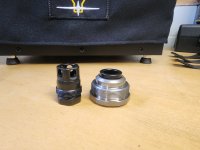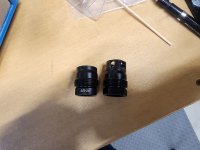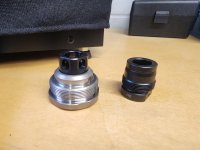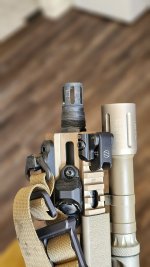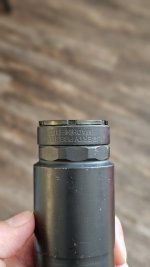Hey folks!
I wanted to provide a summary of some mounting options out on the market for HUB or 1.375x24 threaded suppressors. There are a ton of systems out on the market, each with their own spec, weights, and lengths, and I wanted to highlight some of what I've found through experience, to help inform purchase decisions. Hopefully this sparks some discussion or encourages some thought about your own setups, and why you choose what you did.
I will say that I am currently switching to rearden atlas for my sdn6, coming from keymo and hellfire. This is temporary until I have a dedicated bolt gun can, but I want to share between bolt guns and gas guns...until my kgm r30 clears. Then it's back to hellfire for bolt guns for me.
Holler! Photos below for you visual learners.
Mount overview
System weight: muzzle device and bravo spec adapter weight.
Length added to suppressor: adapter length when added to suppressor.
Length added from barrel shoulder to rear of suppressor: length of total system when muzzle device is inside adapter.
Keymo.
System weight: 8.4oz.
Length added to suppressor: 1.15".
Length added from barrel shoulder to rear of suppressor: 1.32"
Area 419 Hellfire.
System weight: 3.3oz.
Length added to suppressor: 0.35".
Length added from barrel shoulder to rear of suppressor: 0.35
Plan B spec/Rearden Atlas.
System weight: 4.4oz.
Length added to suppressor: 0.5".
Length added from barrel shoulder to rear of suppressor: 0.65".
Keymo Pros.
Good lockup.
Industry support.
Keymo cons.
Heavy.
Long.
Area 419 hellfire pros.
Lightest overall.
Minimal length added.
Ability to run highly effective muzzle brakes when un suppressed.
Amazing return to zero.
Adapters for nearly every suppressor made.
Best for precision rifle applications.
Area 419 cons.
Looks goofy AF on small diameter barrels.
Limited muzzle device options.
Muzzle device is separate from suppressor mount.
Plan B/Rearden Atlas pros.
Light and compact for QD style system. Solid overall system.
Usable muzzle devices when un suppressed.
Effective taper mount.
Lots of aftermarket support.
Affordable.
Threads feel buttery.
Plan B/Rearden Atlas Cons
Q.
Keymo

Hellfire

Rearden fhd

Q cherry bomb

Keymo
 hellfire
hellfire
 rearden atlas and rearden fhd
rearden atlas and rearden fhd

Rearden atlas and q cherry bomb

I wanted to provide a summary of some mounting options out on the market for HUB or 1.375x24 threaded suppressors. There are a ton of systems out on the market, each with their own spec, weights, and lengths, and I wanted to highlight some of what I've found through experience, to help inform purchase decisions. Hopefully this sparks some discussion or encourages some thought about your own setups, and why you choose what you did.
I will say that I am currently switching to rearden atlas for my sdn6, coming from keymo and hellfire. This is temporary until I have a dedicated bolt gun can, but I want to share between bolt guns and gas guns...until my kgm r30 clears. Then it's back to hellfire for bolt guns for me.
Holler! Photos below for you visual learners.
Mount overview
System weight: muzzle device and bravo spec adapter weight.
Length added to suppressor: adapter length when added to suppressor.
Length added from barrel shoulder to rear of suppressor: length of total system when muzzle device is inside adapter.
Keymo.
System weight: 8.4oz.
Length added to suppressor: 1.15".
Length added from barrel shoulder to rear of suppressor: 1.32"
Area 419 Hellfire.
System weight: 3.3oz.
Length added to suppressor: 0.35".
Length added from barrel shoulder to rear of suppressor: 0.35
Plan B spec/Rearden Atlas.
System weight: 4.4oz.
Length added to suppressor: 0.5".
Length added from barrel shoulder to rear of suppressor: 0.65".
Keymo Pros.
Good lockup.
Industry support.
Keymo cons.
Heavy.
Long.
Area 419 hellfire pros.
Lightest overall.
Minimal length added.
Ability to run highly effective muzzle brakes when un suppressed.
Amazing return to zero.
Adapters for nearly every suppressor made.
Best for precision rifle applications.
Area 419 cons.
Looks goofy AF on small diameter barrels.
Limited muzzle device options.
Muzzle device is separate from suppressor mount.
Plan B/Rearden Atlas pros.
Light and compact for QD style system. Solid overall system.
Usable muzzle devices when un suppressed.
Effective taper mount.
Lots of aftermarket support.
Affordable.
Threads feel buttery.
Plan B/Rearden Atlas Cons
Q.
Keymo
Hellfire
Rearden fhd
Q cherry bomb
Keymo
Rearden atlas and q cherry bomb

